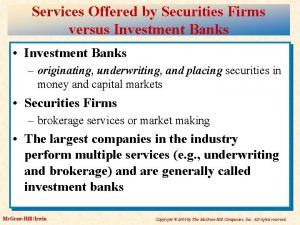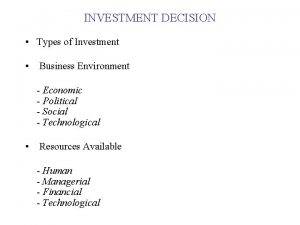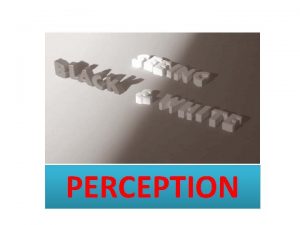The Investment Decision How Firms Organize the Investment






- Slides: 6

The Investment Decision • How Firms Organize the Investment Process – Once a year, a firm’s head office will generally ask to provide a list of the investments they would like to make. – A list of planned investments is called the capital budget. • This “wish list” must then be examined to determine which projects should go forward. – Capital budgeting is a cooperative effort with some challenges: • Forecasts from divisions must be consistent • Conflicts of interests must be eliminated • Forecast bias must be reduced – Senior management must look behind NPVs and understand why they are positive or negative. Semih Yildirim ADMS 3530 9 -1

Some “What If” Questions • Managers want to understand more than the NPV of a project. – If NPV is positive, they must seek to understand why such an attractive project did not come from a competitor. – And if the firm goes ahead with the project, and other copy a such a profitable idea, will the firm still have some competitive advantage? • They also want to predict what events could happen in an uncertain environment they operate and how that might affect NPV. – Once they have done these predictions, management can decide if it is worthwhile investing more time and effort in understanding the uncertainty and trying to resolve it. Semih Yildirim ADMS 3530 9 -2

Some “What If” Questions • Introduction – There are five methods managers use to handle project uncertainty: • Sensitivity Analysis • Scenario Analysis • Simulation Analysis • Break-Even Analysis • Operating Leverage Analysis Semih Yildirim ADMS 3530 9 -3

Some “What If” Questions • Sensitivity Analysis – A sensitivity analysis calculates the consequences of incorrectly estimating a variable in your NPV analysis. – If forces you: • To identify the variables underlying your analysis. • To focus on how changes to these variables could impact the expected NPV. • To consider what additional information should be collected to resolve uncertainties about the variables. Semih Yildirim ADMS 3530 9 -4

Some “What If” Questions • Sensitivity Analysis • You now know how badly the project could be thrown off course by changes in certain variables. • Looking at the previous table, can you answer following questions: – What is the least critical variable to the success of the project? – What are two most critical variables to the success of the project? • You can see that the principal uncertainties come from sales and variable costs, under pessimistic assumptions, NPV could be significantly negative – If your sales are $14 mil. instead of $16 mil. the NPV is -$1. 2 mil. – If your variable costs are set at 83% if sales, NPV is -$0. 8 mil. • Fixed costs is the least critical variable, even the pessimistic assumption would lead to a positive NPV Semih Yildirim ADMS 3530 9 -5

Some “What If” Questions • Sensitivity Analysis • Now that you have identified the critical success/failure factors, you may wish to focus your attention on them: – You might collect additional data on sales and costs so as to resolve some of the uncertainty concerning these variables • Sensitivity analysis is not a “cure-all”. • It does have its drawbacks: – The results are ambiguous since the terms “optimistic” and “pessimistic” are completely subjective. – Variables are often related and it may be difficult to identify all of the consequences associated with a change in one of them. • When variables are interrelated, it may be helpful to look at how the project would fare under different scenarios. – Scenario analysis allows us to look at different but consistent combinations of variables Semih Yildirim ADMS 3530 9 -6











